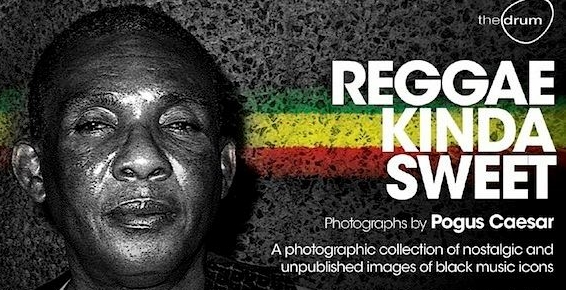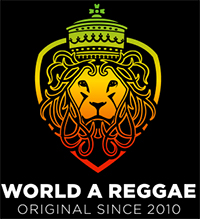Photographer Pogus Caesar’s ‘Reggae Kinda Sweet’ photographic exhibition is at The Drum, Potters Lane, Birmingham UK until 31st August. I recently sat down with the photographer to ask him about his experiences building this extraordinary photo archive.
Many are aware of your photographs and may have even caught your exhibit and book Muzik Kinda Sweet. Talk a bit about your new collection titled Reggae Kinda Sweet and how it differs from your previous work?
“‘Muzik Kinda Sweet,’ as a collection includes photographs I took of black musicans, and ranges from Stevie Wonder, Grace Jones to Cameo and Jay Z. After the 2011 exhibition at British Music Experience, O2 London, the Reggae artists recieved the most responses, so we decided to develop ‘Reggae Kinda Sweet.’ The first space we exhibited in was Trinity Centre, Bristol, UK, 2012- a beautiful old church, a vast space, high vaulted ceilings, when the light filtered through stained glass windows onto the photographs of Burning Spear, Junior Delgado and Freddie McGregor, a truly magical experience. I am really pleased how audiences warm to those images of Jamaica’s finest, so I’m glad my small contribution is appreciated.”
During what years were these photos taken for Reggae Kinda Sweet?
“The ‘Reggae Kinda Sweet’ archive started in 1985, when stated working in TV, the first photograph was of Burning Spear, he came to Birmingham to be interviewed and we did a little photo session afterwards. Throughout the years I have had the honour to shoot images with the likes of Junior Reid, Junior Delgado, Delroy Wilson, Rita Marley, Big Youth, Ijahman Levi, Prince Allah. The most recent photograph is of Ken Boothe, taken in 2011. Because there are numerous projects ongoing, I can’t always exclusively concentrate on the ‘Reggae Kinda Sweet’ archive.”
Do you have a favorite reggae artist whose music you really connect with? Were you able to meet and photograph the artist? Tell us about that experience.
“As a favourite artist it has to Dennis Brown, such a vocal range, his music has always inspired me. A really nice person with a sense of humour. At the time, 1986, I was a presenter on a Birmingham TV series and interviewed DB, he was open and relaxed. After the interview, we hung out for a while and he readily agreed to be photographed. I met him again at Reggae Sunsplash 1987 and was greeted with the biggest smile and warmest greeting. But there are so many experiences, including driving around London with Alton Ellis, Sly Dunbar inviting me onstage during a souncheck, visiting a West Indian takeway with Mighty Diamonds or a interesting couple of days in the company of Lee “Scratch” Perry.’ Those experiences will be embedded in my physche forever.”
Your photos are brilliant. I really dig the black and white. Gives it sort of a classic or vintage feel just like reggae music. Do you shoot only in black and white?
“I nearly always shoot in black & white, usually 400asa film. The camera is an old battered 1980’s Canon Sureshot, I have not moved to digital as yet, maybe in time. With a film camera, you cannot flick a swith and see what you have shot. There is the process, take film to the lab, get back the contact sheet and hope for the best. I love the grain in film, that slight unstability it throws up. The Canon is an old friend, it has borne witness to many situations.”
You photographed one of my reggae heroes in Augustus Pablo. Did you get to know him at all?
“Augustus Pablo was introduced to me by Brent Clarke in 1989, we met in Ladbroke Grove, I spent time with him in a little cafe/coffee shop. Speaking about a range of things, Pablo mainly listened. I was very intrested in his productions, Hugh Mundell, Norris Reid and Te Track in particular, Pablo answered a few words at a time. When it was time to take the photographs, he said something like “yu no haffe tek more than two shot.” So I did.”
Were there any artists who refused to be photographed?
“I have to say, none of the artists refused to be photographed, all were humble, friendly and open. When I’m taking photographs, it’s important to work quickly and make the subject feel at ease. Shooting with a small film camera, it’s essential to consider a range of things, from available light to how effectively you can use the 36 frames on the film.”
As a collector/archivist I am very interested in the preservation of this music and all of my efforts on the blog site are geared toward respect and preservation. I think photographers play an essential role in preserving reggae history. Talk a bit about how you see this role.
“As photographers/archivists, we are allowed so much access, it’s important not to waste the opportunities we are given. Through my portal, OOM Gallery Archive, we are constantly updating the negatives, and also working with a range of institutions who have a interest and understanding of the importance of Reggae and it’s musical legacy.”
When will your Reggae Kinda Sweet exhibit open and where? Is there another book planned?
The ‘Reggae Kinda Sweet’ photographic exhibition is at The Drum, Potters Lane, Birmingham UK until 31st August. Unfortunately, due to lack of space we can only exhibit a small selection of photographs. Having all those influential artists in one space, the public response has been really positive. As for a publication, it would be great to find a writer and publisher to collaborate on the book version of ‘Reggae Kinda Sweet,’ there can never enough books about Reggae and it’s major influence on world music. However, I’m keeping busy. There are two books we are working on at present, ‘Johannesburg – A Brighter Flame’ and another with the Rastafarian writer and poet Benjamin Zephaniah.”
Read more about the exhibit at www.oomgallery.co.uk
Photo: Dee Johnson




